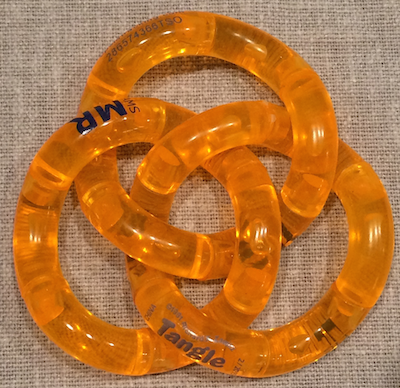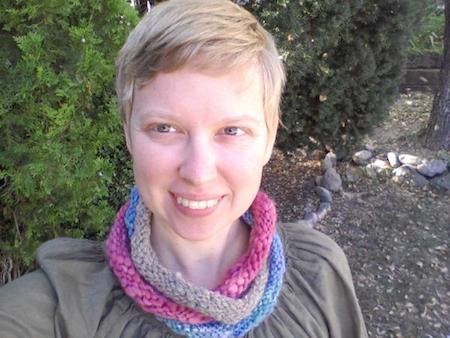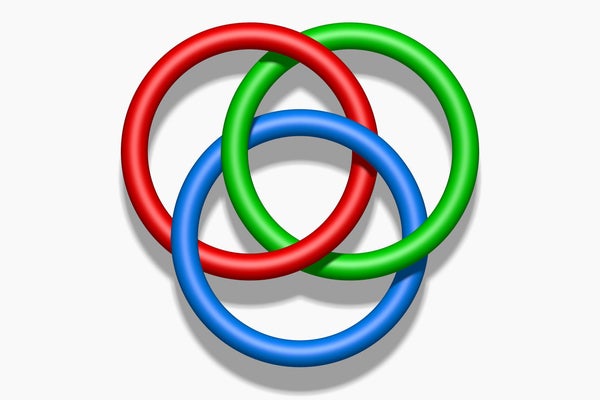This article was published in Scientific American’s former blog network and reflects the views of the author, not necessarily those of Scientific American
This picture is a beautiful lie. It depicts three identical perfect circles: red, green, and blue. Red over green, green over blue, blue over red. But if you sit down with three binder rings or other rigid, perfect circles, you will not be able to recreate it. If you want to make the Borromean rings in real life, you’ll need to compromise. You can make it with something bent.

Credit: EVELYN LAMB
Or with ellipses rather than perfect circles.
On supporting science journalism
If you're enjoying this article, consider supporting our award-winning journalism by subscribing. By purchasing a subscription you are helping to ensure the future of impactful stories about the discoveries and ideas shaping our world today.

Credit: V8rik and 62.129.121.63 WIKIMEDIA (CC BY-SA 3.0)
Or with something flexible like yarn...

The author models Borromean rings created by mathematician and knitter sarah-marie belcastro. Credit: EVELYN LAMB
…or onions.
But you'll never be able to make the Borromean rings from perfect circles. Luckily the figure is a topological object. Topology is the study of the large-scale properties of an object, the things that remain the same even when you stretch or squish the object, so the exact geometry of the figure is inconsequential. As long as you have three closed rings arranged so that no two of them link but the three cannot be pulled apart, you have Borromean rings.
I have had a thing for the Borromean rings for years now. There’s something so poetic about them. The three rings are strong together, but they fall apart if any one of them is removed. Alternatively, the three rings are trapped together until one of them leaves and sets the others free. I’m kind of surprised there isn’t a Wisława Szymborska poem or Tom Stoppard play that explores the metaphorical possibilities in the Borromean rings. (The figure has, however, appeared in the coat of arms of the Borromeo family, whence it got its name, and more recently in the logo of Ballantine beer.)
When you talk about Borromean rings, people generally assume you mean the version made of three components, but the idea can happen with more rings as well. For any larger number of components, people often use the term Brunnian link instead, after the mathematician Hermann Brunn. A paper by Marc Chamberland and Eugene A. Herman explores unexpected connections between these links and games like rock-paper-scissors and its Big Bang Theory-popularized augmentation rock-paper-scissors-lizard-Spock.
During the London Olympics in 2012, the Numberphile crew proposed using a five-piece version of the Borromean rings as the Olympic logo rather than the current logo, which is topologically the connected sum of four Hopf links.
At the top of this post I noted that the most common depiction of the Borromean rings, that of three perfect circles, is impossible, but they can be rendered as ellipses. Sadly, a real physical version of the Borromean Olympic rings would not even do that well. With higher numbers of links, the components cannot even be convex—they have to bend in somewhere in order to allow enough wiggle room to form the link.
Personally, I think Brunnian links with large numbers of rings can get a little overwhelming and busy. I prefer the simple beauty and beautiful simplicity of the classic three-component version. If you’re like me, once you start thinking about the Borromean rings you’ll have trouble stopping. Doodle them, cook them, make them from yarn or straws or pipe cleaners. Wear them. Play with them. See how many different-looking configurations you can create from the same topological object. Enjoy!
The Cantor Set Fat Cantor Sets The Topologist’s Sine Curve Cantor's Leaky Tent The Infinite Earring The Line with Two Origins The House with Two Rooms The Fano Plane The Torus The Three-Torus The Möbius Strip The Long Line Space-Filling Curves The Wallis Sieve Two Tori Glued along a Slit The Empty Set The Menger Sponge The Connected Sum of Four Hopf Links
